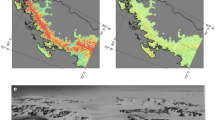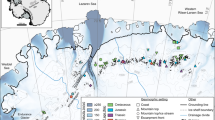Abstract
Some of Earth’s greatest relief occurs where glacial processes act on mountain topography1,2. This dramatic landscape is thought to be an imprint of Pleistocene glaciations3,4. However, whether the net effect of glacial erosion on mountains is to increase5,6,7 or decrease8,9,10 relief remains disputed. It has been suggested that in the European Alps, the onset of widespread glaciation since the mid-Pleistocene climate transition11 led to the growth of large, long-lived and strongly erosive alpine glaciers12,13 that profoundly influenced topography14. Here we use 4He/3He thermochronometry15 and thermal-kinematic models to show that the Rhône Valley in Switzerland deepened by about 1–1.5 km over the past one million years. Our results indicate that while the valley was incised and back-cut, high-altitude areas were preserved from erosion. We find an approximately two-fold increase in both local topographic relief and valley concavity, which occurred around the time of the mid-Pleistocene transition. Our results support the proposed link12,13,14 between the onset of efficient glacial erosion in the European Alps and the transition to longer, colder glacial periods at the middle of the Pleistocene epoch.
This is a preview of subscription content, access via your institution
Access options
Subscribe to this journal
Receive 12 print issues and online access
$259.00 per year
only $21.58 per issue
Buy this article
- Purchase on Springer Link
- Instant access to full article PDF
Prices may be subject to local taxes which are calculated during checkout




Similar content being viewed by others
References
Brocklehurst, S. H. & Whipple, K. X. Response of glacial landscapes to spatial variations in rock uplift rate. J. Geophys. Res. 112, F02035 (2007).
Meigs, A. & Sauber, J. Southern Alaska as an example of the long-term consequences of mountain building under the influence of glaciers. Quat. Sci. Rev. 19, 1543–1562 (2000).
Penck, A. Glacial features in the surface of the Alps. J. Geol. 13, 1–19 (1905).
Molnar, P. & England, P. Late Cenozoic uplift of mountain ranges and global climate change: Chicken or egg? Nature 346, 29–34 (1990).
Montgomery, D. R. Valley formation by fluvial and glacial erosion. Geology 30, 1047–1050 (2002).
Small, E. E. & Anderson, R. S. Geomorphically driven late Cenozoic rock uplift in the Sierra Nevada, California. Science 270, 277–280 (1995).
Shuster, D. L., Cuffey, K. M., Sanders, J. W. & Balco, G. Thermochronometry reveals headward propagation of erosion in an alpine landscape. Science 332, 84–88 (2011).
Brozovic, N., Burbank, D. & Meigs, A. Climatic limits on landscape development in the northwestern Himalaya. Science 276, 571–574 (1997).
Egholm, D. L., Nielsen, S. B., Pedersen, V. K. & Lesemann, J-E. Glacial effects limiting mountain height. Nature 460, 884–887 (2009).
Whipple, K. X., Kirby, E. & Brocklehurst, S. H. Geomorphic limits to climate induced increases in topographic relief. Nature 401, 39–43 (1999).
Lisiecki, L. E. Links between eccentricity forcing and the 100,000-year glacial cycle. Nature Geosci. 3, 349–352 (2010).
Muttoni, G. et al. Onset of major Pleistocene glaciations in the Alps. Geology 31, 989–992 (2003).
Garzanti, E., Vezzoli, G. & Andò, S. Paleogeographic and paleodrainage changes during Pleistocene glaciations (Po Plain, Northern Italy). Earth Sci. Rev. 105, 25–48 (2011).
Haeuselmann, P., Granger, D. E., Jeannin, P-Y. & Lauritzen, S-E. Abrupt glacial valley incision at 0.8 Ma dated from cave deposits in Switzerland. Geology 35, 143–146 (2007).
Shuster, D. L. & Farley, K. A. 4He/3He thermochronometry. Earth Planet. Sci. Lett. 217, 1–17 (2004).
Farley, K. A. (U–Th)/He dating: techniques, calibrations, and applications. in Noble Gases in Geochemistry and Cosmochemistry (eds Porcelli, D.,Ballentine, C. J. & Wieler, R.) 819–844 (Reviews in Mineralogy and Geochemistry, Vol. 47, 2002).
Shuster, D. L., Ehlers, T. A., Rusmore, M. E. & Farley, K. A. Rapid glacial erosion at 1.8 Ma revealed by 4He/3He thermochronometry. Science 310, 1668–1670 (2005).
Valla, P. G., Herman, F., van der Beek, P. A. & Braun, J. Inversion of thermochronological age–elevation profiles to extract independent estimates of denudation and relief history—I: Theory and conceptual model. Earth Planet. Sci. Lett. 295, 511–522 (2010).
Schlüchter, C. The Quaternary glaciations of Switzerland, with special reference to the Northern alpine foreland. Quat. Sci. Rev. 5, 413–419 (1986).
Norton, K. P., Abbühl, L. M. & Schlunegger, F. Glacial conditioning as an erosional driving force in the Central Alps. Geology 38, 655–658 (2010).
Schmid, S. M., Fügenschuh, B., Kissling, E. & Schuster, R. Tectonic map and overall architecture of the Alpine orogen. Ecl. Geol. Helv. 97, 93–117 (2004).
Glotzbach, C., van der Beek, P. A. & Spiegel, C. Episodic exhumation and relief growth in the Mont Blanc massif, Western Alps from numerical modelling of thermochronology data. Earth Planet. Sci. Lett. 304, 417–430 (2011).
van der Beek, P. A. et al. Inversion of thermochronological age–elevation profiles to extract independent estimates of denudation and relief history—II: Application to the French Western Alps. Earth Planet. Sci. Lett. 296, 9–22 (2010).
Schildgen, T. F., Balco, G. & Shuster, D. L. Canyon incision and knickpoint propagation recorded by apatite 4He/3He thermochronometry. Earth Planet. Sci. Lett. 293, 377–387 (2010).
Flowers, R. M., Ketcham, R. A., Shuster, D. L. & Farley, K. A. Apatite (U–Th)/He thermochronometry using a radiation damage accumulation and annealing model. Geochim. Cosmochim. Acta 73, 2347–2365 (2009).
Braun, J. Pecube: A new finite-element code to solve the 3D heat transport equation including the effects of a time-varying, finite amplitude surface topography. Comp. Geosci. 29, 787–794 (2003).
Mudelsee, M. & Raymo, M. E. Slow dynamics of the Northern Hemisphere glaciation. Paleoceanography 20, PA4022 (2005).
Berger, A. L. et al. Quaternary tectonic response to intensified glacial erosion in an orogenic wedge. Nature Geosci. 1, 793–799 (2008).
Champagnac, J-D., Molnar, P., Anderson, R. S., Sue, S. & Delacou, B. Quaternary erosion-induced isostatic rebound in the western Alps. Geology 35, 195–197 (2007).
Hinderer, M. Late Quaternary denudation of the Alps; valley and lake fillings and modern river loads. Geodin. Acta 14, 231–263 (2001).
Acknowledgements
We thank J-D. Champagnac for field assistance, F. Cœur, B. Lum and F. Senebier for help during sample preparation. The staff of the Caltech Noble Gas Laboratory is acknowledged for conducting (U–Th–Sm)/He analyses. We thank G. Balco for development of the 4He/3He thermochronometry search algorithm, F. Chirouze and R. Delunel for fruitful discussions. M. Brandon and S. Brocklehurst provided constructive reviews. Financial support for this work was provided by the French Agence Nationale de la Recherche (ANR-08-BLAN-0303-01 grant to P.A.vd.B.), European Science Foundation Topo-Europe Eurocores programme, France-Berkeley Fund, US National Science Foundation (EAR-0720225 grant to D.L.S.) and the Ann and Gordon Getty Foundation.
Author information
Authors and Affiliations
Contributions
P.G.V. conducted fieldwork, processed samples and performed numerical modelling; P.G.V. and D.L.S. conducted 4He/3He analyses; all authors contributed equally to the design of the study and writing of the paper.
Corresponding author
Ethics declarations
Competing interests
The authors declare no competing financial interests.
Supplementary information
Supplementary Information
Supplementary Information (PDF 1070 kb)
Rights and permissions
About this article
Cite this article
Valla, P., Shuster, D. & van der Beek, P. Significant increase in relief of the European Alps during mid-Pleistocene glaciations. Nature Geosci 4, 688–692 (2011). https://doi.org/10.1038/ngeo1242
Received:
Accepted:
Published:
Issue Date:
DOI: https://doi.org/10.1038/ngeo1242
This article is cited by
-
Palaeomagnetic and mineral magnetic analyses of the Deckenschotter of northern Switzerland and southern Germany
Swiss Journal of Geosciences (2023)
-
Medieval demise of a Himalayan giant summit induced by mega-landslide
Nature (2023)
-
Who venerated the ancestors at the Petit-Chasseur site? Examining Early Bronze Age cultic activities around megalithic monuments through the archaeometric analyses of ceramic findings (Upper Rhône Valley, Switzerland, 2200–1600 BC)
Archaeological and Anthropological Sciences (2023)
-
Controls on the regional distribution of landslide dams and implications for fluvial landform evolution in Bhutan and its surrounding area
Journal of Mountain Science (2023)
-
Early Pleistocene complex cut-and-fill sequences in the Alps
Swiss Journal of Geosciences (2022)



